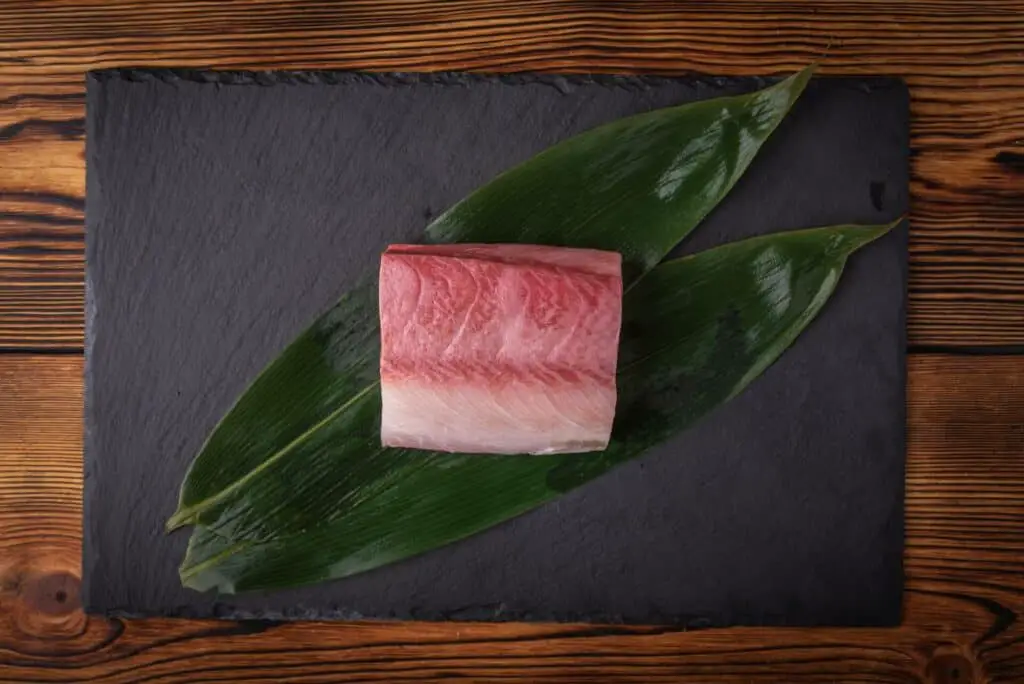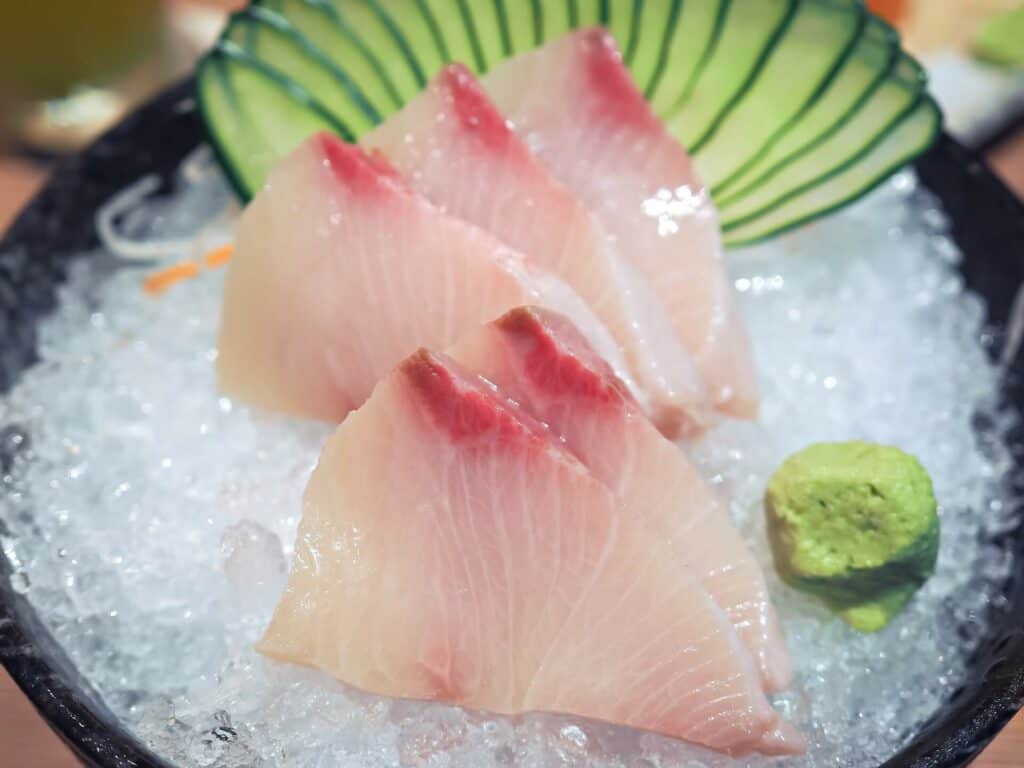If you are new to sushi, you have probably come across the term hamachi and found it confusing. What is sushi hamachi? If you want to find out everything about this, my article will come in handy. Check out what I’ve written on hamachi, so you know whether to order it or not the next time you visit a Japanese restaurant.
So, what is sushi hamachi? Hamachi, otherwise known as buri, is a Japanese amberjack fish. It’s a species of jackfish in the family Carangidae, commonly used for preparing various sushi rolls. It’s popular in both Japan and the US. Hamachi can be eaten raw or cooked.


Hamachi is an unavoidable part of the real sushi experience. This delicious fish has many names, which often leads consumers to confusion. If you want to understand everything about hamachi, keep reading. I’ve explained everything you need to know in order to improve your knowledge of sushi and eventually show off the next time you visit your favorite Japanese restaurant.
What Is Sushi Hamachi and Why You Should Try It?
Hamachi is a fish often used when preparing sushi. It’s popular in the US and Japan, and it’s considered among the most delicious types of fish that can be a part of sushi rolls. I believe that you should never eat sushi without at least a little bit of this specialty – hamachi enhances the flavor of everything it’s added in and makes your taste buds dance with joy.
What Type of Fish Is Hamachi?
Hamachi is Japanese amberjack or buri – another name for it is yellowtail. It lives in the Pacific Ocean, from Korea to Hawaii. A part of consumed hamachi is wild fish, but most of it is farmed – farmed versions have higher fat content. Hamachi also has many other names, depending on which part of Japan you’re in.
- Wakashi in Kanto,
- Tsubasu in Kansai,
- Inada in Warasa,
- Mejiro in Kansai.
Hamachi Is an Essential Part of Sushi Experience – Plus, It’s Healthy
As I’ve mentioned, hamachi is an extremely important sushi ingredient – at least for me. Some might find it not so delicious, but trust me – those people are in the minority. Most sushi lovers can’t imagine eating sashimi or nigiri that doesn’t contain hamachi.
Hamachi isn’t only delicious – it’s very beneficial for your health. You probably already know that many sushi ingredients are healthy, but I must say that yellowtail has some great nutrients. The key ones are omega-3 fatty acids. The human body can’t produce these, so we have to get them from food, and fish is the usual source of omega-3.
Hamachi contains high levels of these good fatty acids, so why not eat something delicious and healthy at the same time? However, keep in mind that cooking the fish can eliminate a small amount of omega-3. It’s not enough for it to lose its nutritional value, but it’s still good to know that the raw one is better. Here is nutritional information on Japanese amberjack:
| Serving size | 1 oz (28.3 g) |
| Calories | 41.3 kcal |
| Total fat | 1.5 g |
| Carbohydrates | 0 g |
| Protein | 6.7 g |
| Sodium | 0.011 g |
| Potassium | 0.119 g |
Interested to know more about other Japanese delicacies? Read also :
What Sushi Is White?
What Is Thai Sushi?
What Is Chicken Sushi?
What Is Masago?
Is Nigiri Sushi?
What Does Hamachi Taste Like?
Raw hamachi has an incredible taste. This isn’t just my opinion – most sushi fans would agree with me. This fish has quite a rich flavor, yet very delicate. It’s a mix of a little savory and a little sweet, with somewhat of a clean taste. When you bite into hamachi, it will be a smooth, crisp bite.
Japanese amberjack has high-fat content, making the fish taste a bit creamy – or buttery if that paints a better picture. That’s why chefs often use it for nigiri. If you were wondering what yellowtail should look like when it’s fresh – it should be light pink, sort of opaque, with a bit of brownish tint.
Is Hamachi Tastier Than Tuna and Mackerel?
Although you can frequently find hamachi listed on the menus as yellowtail tuna, it doesn’t belong to the same family as tuna and mackerel. They are a part of the Scombridae family and don’t taste much alike.
In my opinion, hamachi has a superior taste to tuna and mackerel. Not that there’s anything wrong with tuna or mackerel – it’s just that hamachi tastes cleaner and less fishy. That’s why I believe it’s a perfect type of fish for most sushi lovers. It will be suitable for those who hate fishy smell and taste but will also appeal to those who don’t mind intense flavors.

How Do You Serve Hamachi?
Of course, sushi is a very broad term – there are many types of sushi rolls and appetizers that contain hamachi. I love sashimi the most, but I often eat other dishes with hamachi as well. This delicious fish is most commonly prepared in the dishes I’ve listed below.
- Hamachi maki – Maki roll is rolled sushi that can be hand-rolled or made with a bamboo mat (makisu), and it always contains sushi rice and toppings wrapped in toasted nori seaweed. Hamachi maki are usually made with scallion for an added crunchy taste.
- Hamachi nigiri – Nigiri is an oblong ball of rice topped with a slice of raw fish and a bit of wasabi. With hamachi nigiri, you can often see a slice of jalapeno added on top of the fish to enhance the flavor.
- Hamachi sashimi – Sashimi is a traditional Japanese presentation of raw fish (or meat). Fish is thinly sliced and arranged carefully alongside additional ingredients such as freshly grated ginger, shredded daikon radish, and minty shiso leaves. There will usually be wasabi and soy sauce or sushi sauce presented with sashimi as well. Some chefs serve hamachi sashimi lightly grilled.
- Hamachi donburi – Donburi is a Japanese rice bowl made in countless varieties. Donburi can incorporate vegetables, eggs, fish, or meat – with various spices. When serving hamachi donburi, hamachi can be raw or cooked.
Hamachi Should Always Be a Part of Your Sushi Meal
As you can see, hamachi is a fish with many names, but also many fans. I don’t know anyone who doesn’t like thin slices of this delicious, creamy, raw fish. If you haven’t tried it yet, I suggest you do that the first chance you get. You will most likely fall in love – hamachi is the perfect ingredient for every sushi roll, and it’s a healthy addition to your meal. Does food get any better than that?